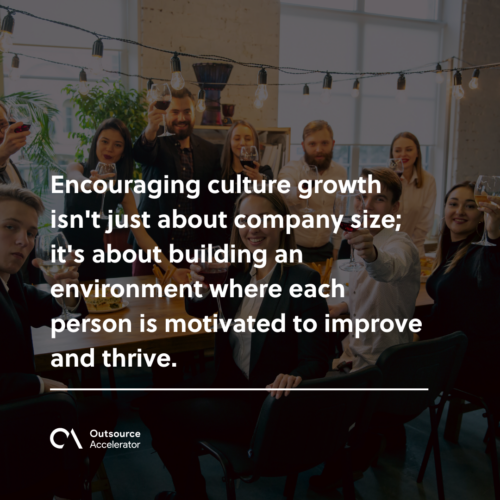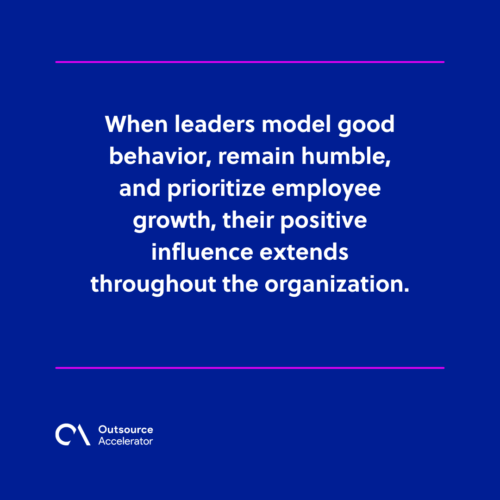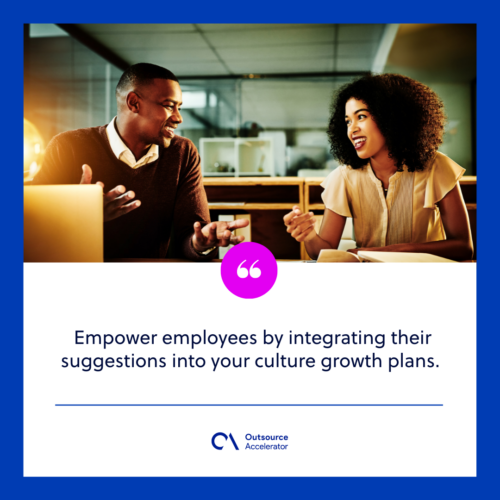Cultivating a culture of growth within the organization

Cultivating a culture of growth within a company is vital. It goes beyond mere trends; it’s now a fundamental requirement.
This article explores the core of culture growth, its importance, and practical methods to make it happen.
Definition of culture growth
Encouraging culture growth isn’t just about company size; it’s about building an environment where each person is motivated to improve and thrive.
This culture appreciates innovation, teamwork, and collective excellence. It lets employees harness their skills, urging them to own their responsibilities.

Why culture growth matters
The impact of culture growth within an organization cannot be underestimated, as it influences every facet of the company, from how employees interact to decisions.
This influence directly affects three vital domains:
Enhancing employee engagement
Fostering a culture of growth begins with actively engaging employees. This involves creating an environment where individuals connect strongly with their work and the company’s mission. Trusted outsourcing providers, like Cloudstaff, are committed to achieving this goal by prioritizing employee engagement and alignment with its mission.
This involvement encourages employees to direct their energy, creativity, and passion into tasks, leading to improved performance and a deep sense of fulfillment.
Increasing employee productivity
When employees are inspired to discover their potential and take on new challenges, it boosts productivity.
Help employees prioritize tasks by identifying the most important and time-sensitive ones. This prevents them from feeling overwhelmed and helps them focus on what matters most.
Improving employee retention
An organization that values employee development and well-being cultivates higher retention rates.
A culture growth fosters loyalty and dedication, with employees acknowledging the organization’s commitment to their career progression.
A decreased turnover results in a steady workforce. It helps the firm to save time and resources from having to recruit and hire new staff.
Strategies for fostering culture growth
Cultivating culture growth includes strategies that match the organization’s values and goals. Here are some effective approaches businesses can implement:
Effective leadership
Leaders profoundly affect how a company’s culture forms. When they model good behavior, remain humble, and prioritize employee growth, their positive influence extends throughout the organization.

Leaders should:
Lead by example
Leaders who consistently pursue learning, welcome feedback, and embrace change set an example for ongoing growth. Employees who see leaders dedicated to growth are motivated to do the same.
Encourage open communication
Schedule regular one-on-one meetings with employees to discuss their progress, challenges, and any feedback they may have.
Conduct team meetings to facilitate information sharing, brainstorming, and collaboration. Make sure everyone has a chance to contribute.
Provide growth opportunities
Employees require chances to develop their skills and embrace fresh tasks.
Training, mentorship, and diverse projects boost their abilities and demonstrate the organization’s commitment to their growth.
Offer opportunities for promotion based on merit and achievement. Regularly review employees’ performance and reward those who excel.
Build a positive work environment
Creating a positive work environment and fostering a culture of growth is essential for the well-being and success of both employees and the organization.
Here are some key steps to achieve this:
Foster collaboration and teamwork
Promote collaboration among teams by eliminating barriers and fostering a shared goal. When employees work together, they combine their strengths to achieve improved results.
Ensure your team has the tools, information, and resources to work together smoothly. Not having enough resources can make collaboration difficult and cause frustration.
Recognize and reward achievements
Acknowledging the efforts and achievements of employees boosts their morale and reinforces the connection between performance and recognition.
Appreciation can take various forms, like public acknowledgment or personalized rewards.
Promote work-life balance
Urge employees to take their vacation and paid time off. Ensure they know it’s okay to take breaks and recharge.
When feasible, provide flexible hours or remote work opportunities. Letting employees adjust their schedules to their needs promotes a healthier work-life balance.
Measuring and evaluating culture growth
Measuring and assessing the results is crucial to ensure that culture growth initiatives are successful. Here’s how to approach it:
Identify key metrics
Measuring a company culture’s growth is tough due to its intangible nature. Still, you can gauge progress and impact using these key metrics:
Employee satisfaction surveys
Promote participation by emphasizing the importance of the survey and its potential impact. Consider using incentives to encourage employees to complete the survey.
Communicate the purpose of the survey to employees. Explain how their feedback will be used to drive positive changes in the workplace.
Employee retention rates
Observing the rate at which employees leave provides a clear view of how well your culture growth endeavors retain talent. A decrease in turnover signals that employees appreciate the organization’s culture.
Ensure that compensation packages are competitive within the industry. Fair and transparent pay practices contribute to employee satisfaction and retention.
Employee performance metrics
Assess an employee’s ability to communicate clearly and effectively with colleagues, managers, and clients.
Track employees’ progress on performance improvement plans to ensure they meet the outlined goals and expectations.
Improved performance often results from employees’ motivation and support.
Continuous assessment
Developing culture growth is an ongoing effort; it necessitates continuous evaluation and adaptation. Here’s how to sustain progress:
Regularly review and adjust strategies
Regularly review the efficiency of your tactics and adapt them as needed. Use input, patterns, and evolving organizational requirements as your guide.
Assess your organization’s strengths, weaknesses, opportunities, and threats (SWOT analysis). This helps identify areas where your strategies need adjustment.
Gather feedback from employees
Establishing channels for employees to share feedback guarantees that their opinions are valued. Their perspectives can offer valuable direction on areas that require enhancement or adjustment.
Show appreciation for the feedback you receive, whether positive or constructive, to encourage ongoing participation.
Incorporate employee suggestions
Empower employees by integrating their suggestions into your culture growth plans. This validates their input and enhances their feeling of ownership and involvement.
Keep records of the suggestions and their outcomes. Document lessons learned and use them to refine future processes.
Prioritize your organization’s culture growth today
Creating a culture of growth is crucial. Organizations can build a thriving workplace by using strategies that increase employee engagement, productivity, and retention.
Companines can develop a culture that supports employee progress and drives long-term success with effective leadership, a supportive environment, and ongoing assessment.
Remember that culture growth is ongoing and requires dedication, adaptability, and a genuine commitment to employee well-being and the organization’s health as a whole.








 Independent
Independent




